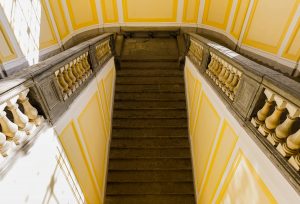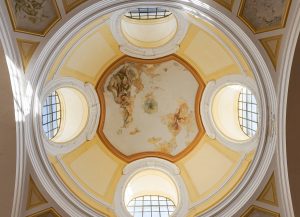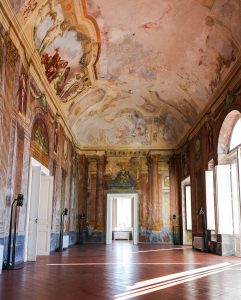point
08
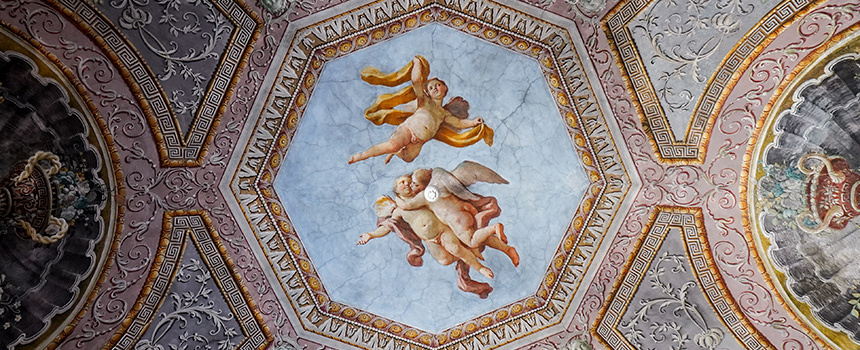
The Campolieto artists
In order to be able to achieve that ‘extra’ that the client had requested for the luxurious interiors, Vanvitelli involved the best artists of the time in the project.
Some of the most noteworthy painters involved were Fedele Fischetti, Gaetano Magrì, Giuseppe Funari, Jacopo Cestaro and Crescenzo La Gamba, who worked alongside the great artisans and decorators of the time, among which it is worth to mention Gerardo Solofrano and Pasquale De Matteis, as well as gilders and plasterers.
It is the same group of masters that the Roman architect had specifically requested for the construction of the royal residence in Caserta, inaugurated in 1751, which he was unable to see completed due to his death in 1773.
Each master showcased his own stylistic code and his own distinctive features following the indications of the architect, who coordinated not only the architectural side but the overall project of the Resina complex, embracing every aspect, from the distribution of space to the decoration of each component. Also noteworthy is the style of the frescoes, a refined Baroque devoted to classicism, perfectly in line with the style envisioned by Vanvitelli.
The room in which we are now, called the “Cannocchiale room”, overlooks the main road (Strada delle Calabrie) and boasts a splendid view of the Vesuvius. In 1771, Jacopo Cestaro was hired to paint the frescoes of this room, in which the great figures of Mercury and Minerva stand at the center of a series of Tuscan arcades, realized by Gaetano Magrì, that recall the external Campolieto arcade, and the vaults of the next three rooms, with the images of Apollo, Diana and Aurora in the private wing of the noble apartment. Cestaro had trained under the best Neapolitan masters of the early eighteenth century, such as Solimena and De Mura, and was highly appreciated by Vanvitelli for his excellent ability with the fresco technique.
The various frescoes in the villa made by various masters were all part of a precise iconographic project conceived by the architect himself. The decorations envisioned for the interiors, and especially for the passage rooms, reproduced the motifs and backgrounds of the gardens, creating a semantic map of the exterior of the villa. The architectural features of the arcade, of the statues in the gardens and of the fountains, gave life to an infinite dialogue between interior and exterior locations, between closed environments and open spaces. Furthermore, the use of illusionistic perspective allowed small or poorly lit rooms to illusively increase the perceived space and the lighting, made even more realistic with the use of trompe l’oeil.
The Pompei lounge
The last room on the right side of the main floor is called “Salottino Pompeiano”. Despite being a country casino, the Di Sangro family furnished its apartments, rooms and lounges with taste and elegance. This environment is clear evidence of it: the refinement of the decorations, the use of warm colors and the preciousness of the fake cameos on the walls pair well with the fact that it was certainly meant to be an intimate, private environment for the Duchess Marianna di Sangro. The other rooms, now devoid of furniture and other decorative elements, were at the time covered with precious silks in warm colors. In fact, documents mention the use of yellow ermisino, in both plain and striped colors, while the leather of the precious seats in gilded walnut were also yellow. Today the frescoed room hosts a small collection of nativity scenes, with one of the main displays being a “scarabattolo” (a type of glass cabinet) with a reproduction of Villa Campolieto as part of the imaginary nativity scene.
You are here
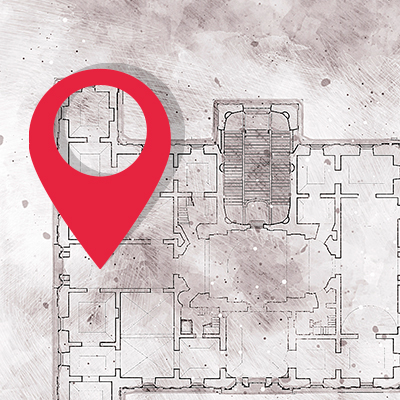
More about
-
Feature Item 1
Lorem ipsum dolor sit amet, consectetur adipisi cing elit, sed do eiusmod tempor incididunt ut abore et dolore magna
-
Feature Item 2
Lorem ipsum dolor sit amet, consectetur adipisi cing elit, sed do eiusmod tempor incididunt ut abore et dolore magna
-
Feature Item 3
Lorem ipsum dolor sit amet, consectetur adipisi cing elit, sed do eiusmod tempor incididunt ut abore et dolore magna



